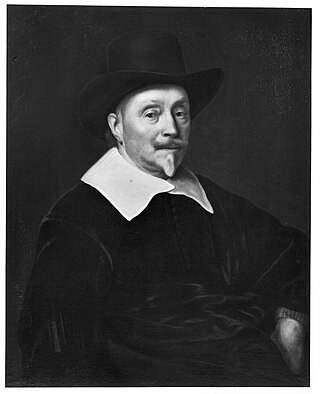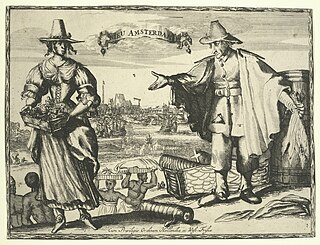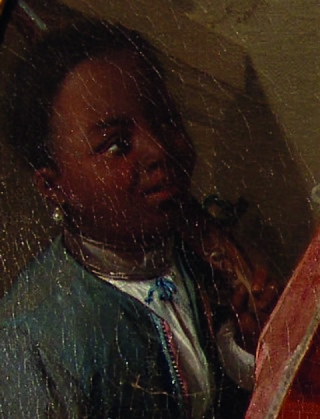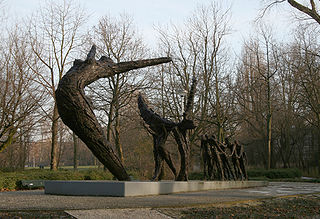
The Beeckestijn was slave ship of the Dutch West India Company. Operating out of Amsterdam, she was depicted in front of the Dutch West India Company warehouses on the Prins Hendrikkade quay by the engraver Hendrik de Leth. [1]

The Beeckestijn was slave ship of the Dutch West India Company. Operating out of Amsterdam, she was depicted in front of the Dutch West India Company warehouses on the Prins Hendrikkade quay by the engraver Hendrik de Leth. [1]
The Beeckestijn [a] was owned by the Dutch West India Company. (As the WIC gave up her monopoly on slave trade in 1730, but kept the Elmina Castle to provide slave traders, a partly privately owned ship is possible.) She made seven voyages transporting slaves from the African west coast to Suriname in South America and St Eustatius in the Caribbean between 1722 and 1736. Forty-six hundred enslaved Africans were transported, of whom at least 1,000 died during the journey; on some voyages the mortality rate was as high as a third. [1]
Beeckestijn’s maiden voyage, under captain Dirk de Wolf, was out of the Dutch port of Texel on 19 February 1721, she had a crew 63, and was mounted with 26 guns.
The engraving of the Beeckestijn depicted above—the only known 18th-century print of a Dutch West India Company ship—was well known, but it was only with the fortuitous discovery of documents by historian Mark Ponte that the ship was linked to the slave trade. [1]
Slavery was finally abolished in Surinam in 1873. [2]
Mark Ponte is the guest curator of the Amsterdammers en Slavernij exhibition at the Amsterdam City Archives (Amsterdamse Stadsarchief) over the summer of 2020. [2] There are no other known contemporary drawings of Dutch slave ships.

The Dutch West India Company was a Dutch chartered company that was founded in 1621 and went defunct in 1792. Among its founders were Reynier Pauw, Willem Usselincx (1567–1647), and Jessé de Forest (1576–1624). On 3 June 1621, it was granted a charter for a trade monopoly in the Dutch West Indies by the Republic of the Seven United Netherlands and given jurisdiction over Dutch participation in the Atlantic slave trade, Brazil, the Caribbean, and North America.

The United East India Company, commonly known as the Dutch East India Company, was a chartered trading company and one of the first joint-stock companies in the world. Established on 20 March 1602 by the States General of the Netherlands amalgamating existing companies, it was granted a 21-year monopoly to carry out trade activities in Asia. Shares in the company could be purchased by any citizen of the United Provinces and subsequently bought and sold in open-air secondary markets. The company possessed quasi-governmental powers, including the ability to wage war, imprison and execute convicts, negotiate treaties, strike its own coins, and establish colonies. Also, because it traded across multiple colonies and countries from both the East and the West, the VOC is sometimes considered to have been the world's first multinational corporation.

Piet Pieterszoon Hein was a Dutch admiral and privateer for the Dutch Republic during the Eighty Years' War. Hein was the first and the last to capture a large part of a Spanish treasure fleet which transported huge amounts of gold and silver from Spanish America to Spain. The amount of silver taken was so large that it resulted in the rise of the price of silver worldwide and the near bankruptcy of Spain.

Samuel Blommaert was a Flemish/Dutch merchant and director of the Dutch West India Company from 1622 to 1629 and again from 1636 to 1642. In the latter period, he was a paid commissioner of Sweden in the Netherlands and he played a dubious but key role in Peter Minuit's expedition that led to the Swedish colonizing of New Sweden. For years Blommaert was involved in the copper trade and industry. In 1645 he was appointed for a third time as a manager of the WIC, being one of the main investors from the beginning.

John Gabriel Stedman was a Dutch States Army officer and writer best known for writing The Narrative of a Five Years Expedition against the Revolted Negroes of Surinam (1796). This narrative covers describes his experience in Suriname between 1773 and 1777, where he was a soldier in a Dutch regiment deployed to assist colonial troops fighting against groups of Maroons. He first recorded his experiences in a personal diary that he later rewrote and expanded into the Narrative. The Narrative was a bestseller of the time and, with its firsthand depictions of slavery and other aspects of colonialism, became an important tool in the fledgling abolitionist movement. When compared with Stedman's personal diary, his published Narrative is a sanitized and romanticized version of Stedman's time in Surinam.

The Asiento de Negros was a monopoly contract between the Spanish Crown and various merchants for the right to provide enslaved Africans to colonies in the Spanish Americas. The Spanish Empire rarely engaged in the transatlantic slave trade directly from Africa itself, choosing instead to contract out the importation to foreign merchants from nations more prominent in that part of the world, typically Portuguese and Genoese, but later the Dutch, French, and British. The Asiento did not concern French or British Caribbean but Spanish America.

The Royal African Company (RAC) was an English trading company established in 1660 by the House of Stuart and City of London merchants to trade along the West African coast. It was overseen by the Duke of York, the brother of Charles II of England; the RAC was founded after Charles II ascended to the English throne in the 1660 Stuart Restoration, and he granted it a monopoly on all English trade with Africa. While the company's original purpose was to trade for gold in the Gambia River, as Prince Rupert of the Rhine had identified gold deposits in the region during the Interregnum, the RAC quickly began trading in slaves, who became its largest commodity.

The Brandenburger Gold Coast, later Prussian Gold Coast, was a colony of Brandenburg-Prussia, later the Kingdom of Prussia, on the Gold Coast. The Brandenburg colony existed from 1682 to 1701, after which it became a Prussian colony from 1701 to 1721. In 1721, King Frederick William I of Prussia sold it for 7,200 ducats and 12 slaves to the Dutch West India Company.
The history of Curaçao starts with settlement by the Arawaks, an Amerindian people coming from the South American mainland. They are believed to have inhabited the island for many hundreds of years before the arrival of Europeans.
Zacharias Wagenaer was a German-born Dutch clerk, illustrator, merchant, member of the Court of Justice, opperhoofd of Deshima and the only German governor of the Dutch Cape Colony. In 35 years he traveled over four continents.
Jan, Johan or Johannes van Walbeeck was a Dutch navigator and cartographer during a 1620s circumnavigation of the earth, an admiral of the Dutch West India Company, and the first governor of the Netherlands Antilles.

Joan or Johan van Scharphuysen, Scharphuizen or Jan van Scherpenhuizen was a Dutch colonist, a judge in Suriname, a slave-trader, colonial governor from 1689 to 1696 on behalf of the Society of Surinam, and a considerable plantation-owner.

Jan Gerritsz. Bicker was a general contractor, shipping magnate, mayor (burgomaster) and a member of the Bicker family, influential regenten from Amsterdam.

Hendrik Carloff, Caerloff or Caarlof was an adventurer and slave trader active in the 17th century. Carloff began his career as a cabin boy but rose to become a commander and governor appointed by the Dutch West India Company and Danish or the Swedish Africa Company on the Gold Coast. Between 1676 and 1677, he was Governor of Tobago.

Surinam, also unofficially known as Dutch Guiana, was a Dutch plantation colony in the Guianas, bordered by the equally Dutch colony of Berbice to the west, and the French colony of Cayenne to the east. It later bordered British Guiana from 1831 to 1966.

West Indiaman was a general name for any merchantman sailing ship making runs from the Old World to the West Indies and the east coast of the Americas. These ships were generally strong ocean-going ships capable of handling storms in the Atlantic Ocean. The term was used to refer to vessels belonging to the Danish, Dutch, English, and French West India companies.

Dorothy Creole was one of the first African women to arrive in New York. She arrived in 1627. That year, three enslaved African women set foot on the southern shore of Manhattan, arriving in the Dutch colony of New Amsterdam. Property of the Dutch West India Company, these women were brought to the colony to become the wives of enslaved African men who had arrived in 1625. One of these women was named Dorothy Creole, a surname that she acquired in the New World.

Adriaan de Bruin, earlier called Tabo Jansz, was an enslaved servant (kammermohr) of Dutch politician Adriaan van Bredehoff. Born in Africa and enslaved, he got to the Dutch Republic by way of either the Dutch Caribbean or in Dutch Surinam, and ended up a free man in Hoorn, North Holland. De Bruin and van Bredehoff stood for a portrait (1727) by Nicolaas Verkolje, now in the Westfries Museum in Hoorn.

The history of slavery in the Netherlands dates back to the period of classical antiquity. During the early modern period, Dutch slave traders bought and sold over 1.6 million enslaved people. The Netherlands abolished Dutch involvement the Atlantic slave trade in 1814 under diplomatic pressure from the United Kingdom, but slavery would continue to exist in the Dutch colonial empire until 1863.